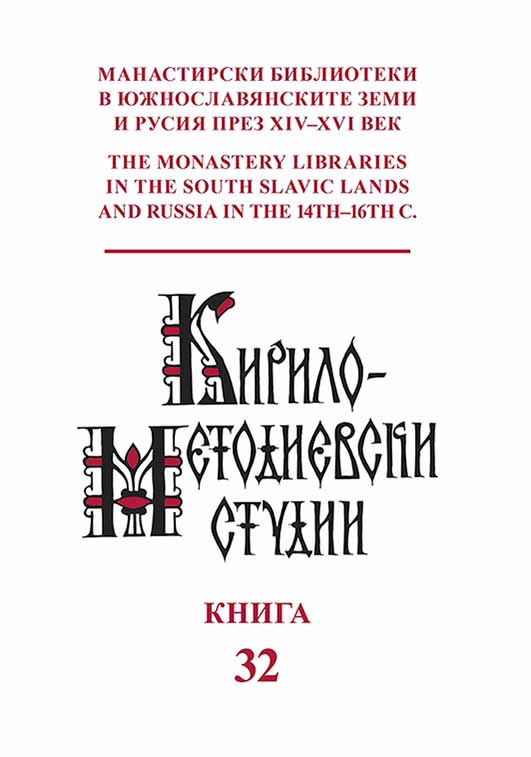За един възможен зографски ръкопис с Никоновите Пандекти от третата четвърт на ХІV в.: ръкопис № 48 от МСПЦ
One Manuscript with the Nikon of the Black Mountain’s Pandectae from the Third Quoter of the 14th с. (MSOCH 48) with Possible Provenance of the Zographu Monastery
Author(s): Nina GagovaSubject(s): Language studies, Language and Literature Studies
Published by: Кирило-Методиевски научен център при Българска академия на науките
Keywords: Pandectae; Zographu monastery; church reforms; hesychasm; miscellanies.
Summary/Abstract: The article aims at analyzing the codicological features and one fragment of the content of the ms. N 48 from the Museum of the Serbian Orthodox Church in Belgrade, containing the Nikon of the Black Mountain’s Pandectae, in one attempt to draw the possible provenance of the ms. and to comment the results in the context of the problems concerning the origin of the so-called “Euthymius” version of the second translation of the Pandectae, to which the mss’ text belongs. The comparison of the ornamentation, writings and watermarks of ms. N 48 with other South Slavic witnesses from the 14. Century lead to conclusion that it very probably originates from the Zographu monastery on Mount Athos - which is indirectly confirmed by the list of holidays celebrated by the workers in the monastery where the manuscript was used. In the same time, codicological peculiarities of the ms. 48 clearly connect it to the manuscripts from the so-called circle of Lavrentiev miscellany (RNL, Moscow, F.I.376, commissioned by Tsar John Alexander (1331–1371) in 1348) produced in Bulgaria, most probably in monasteries associated with the personal patronage of the Tsar in Paroria, Kefalarevo and in vicinity of Tarnovo. Recent research of certain monastic miscellanies containing fragments of the “Euthymius” edition of the Pandectae which provenance is relatively defined (BAS, Sofia, № 80 (Ryapov sbornik), 14th c., Dechani monastery № 75, 1360–1370, Hilandar monastery № 464,15th c.) confirms such connection, relating the second translation of the Pandectae and its later version to the first and second stages of the reforms of the fourteenth century and the spread of hesychasm. In their canonical and legal part, these monastic collections contain so-called Pseudo-Zonaras Nomocanon, present in dogmatic-catechetical compilations intended for lay people (ms. 1160 from the Church Historical and Archive Institute in Sofia), including in collections and mss. related to the pop-Philip miscelany (GIM, Moscow, Sinod. Coll., № 38), commissioned by Tsar John Alexander in 1345 (GIM, Moscow, AI Hludov coll., № 76, 14th c., RAS, St. Petersburg, № 13.3 .17 – Loveshki miscellany, 90s of 14th c.). Finally, it can be concluded that the distribution of the mentioned version of Pandektae and its presence in a manuscript from Zographu monastery, which is most likely ms. № 48, is one more evidence of the constant transmission of texts and translations between Bulgaria and Mount Athos in the 14th century, in which the founding monasteries of the ruler and aristocracy play an important role.
Journal: Кирило-Методиевски студии
- Issue Year: 2022
- Issue No: 32
- Page Range: 137-163
- Page Count: 27
- Language: Bulgarian

